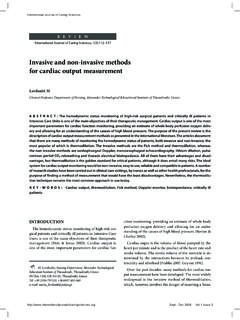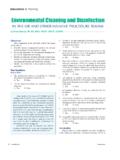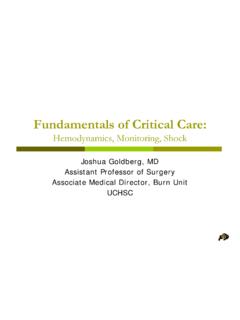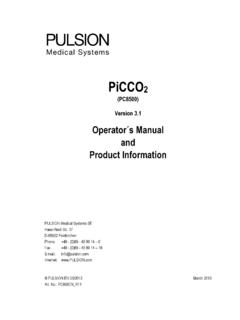Transcription of Minimally Invasive Versus Conventional Open ... - ISMICS
1 ORIGINALARTICLEM inimally Invasive Versus Conventional open Mitral ValveSurgeryA Meta-Analysis and Systematic ReviewDavy C. H. Cheng, MD,* Janet Martin, PharmD, MSc (HTA&M),* Avtar Lal, MD, PhD,*Anno Diegeler, MD, PhD, Thierry A. Folliguet, MD, L. Wiley Nifong, MD, Patrick Perier, MD, Ehud Raanani, MD, J. Michael Smith, MD,# Joerg Seeburger, MD,** and Volkmar Falk, MD Objective:This meta-analysis sought to determine whether mini-mally Invasive mitral valve surgery (mini-MVS) improves clinicaloutcomes and resource utilization compared with Conventional openmitral valve surgery (conv-MVS) in patients undergoing mitralvalve repair or.
2 A comprehensive search of MEDLINE, CochraneLibrary, EMBASE, CTSnet, and databases of abstracts was under-taken to identify all randomized and nonrandomized studies up toMarch 2010 of mini-MVS through thoracotomy Versus conv-MVSthrough median sternotomy for mitral valve repair or of interest included death, stroke, myocardial infarction,aortic dissection, need for reintervention, and any other reportedclinically relevant outcomes or indicator of resource risk and weighted mean differences and their 95% confi-dence intervals were analyzed as appropriate using the randomeffects model.
3 Heterogeneity was measured using the :Thirty-five studies met the inclusion criteria (two random-ized controlled trials and 33 nonrandomized studies). The mortalityrate after mini-MVS Versus conv-MVS was similar at 30 days ( ), 1 year ( vs ), 3 years ( vs ), and 9years (0% vs ). A number of clinical outcomes were signifi-cantly improved with mini-MVS Versus conv-MVS including atrialfibrillation (18% vs 22%), chest tube drainage (578 vs 871 mL),transfusions, sternal infection ( vs ), time to return tonormal activity, and patient scar satisfaction. However, the 30-dayrisk of stroke ( vs ), aortic dissection/injury ( vs 0%),groin infection (2% vs 0%), and phrenic nerve palsy (3% vs 0%)were significantly increased for mini-MVS Versus conv-MVS.
4 Otherclinical outcomes were similar between groups. Cross-clamp time,cardiopulmonary bypass time, and procedure time were significantlyincreased with mini-MVS; however, ventilation time and length ofstay in intensive care unit and hospital were :Current evidence suggests that mini-MVS maybeassociated with decreased bleeding, blood product transfusion, atrialfibrillation, sternal wound infection, scar dissatisfaction, ventilationtime, intensive care unit stay, hospital length of stay, and reducedtime to return to normal activity, without detected adverse impact onlong-term need for valvular reintervention and survival beyond 1year.
5 However, these potential benefits for mini-MVS may comewith an increased risk of stroke, aortic dissection or aortic injury,phrenic nerve palsy, groin infections/complications, and increasedcross-clamp, cardiopulmonary bypass, and procedure time. Avail-able evidence is largely limited to retrospective comparisons ofsmall cohorts comparing mini-MVS Versus conv-MVS that provideonly short-term outcomes. Given these limitations, randomizedcontrolled trials with adequate power and duration of follow-up tomeasure clinically relevant outcomes are recommended to determinethe balance of benefits and Words:Systematic review, Meta-analysis, Mitral valve sur-gery, Minimally Invasive surgery.
6 (Innovations2011;6:84 103)Accepted for publication December 31, the *Department of Anesthesia & Perioperative Medicine, Evidence-Based Perioperative Clinical Outcomes Research Group (EPiCOR), Lon-don Health Sciences Centre, University of Western Ontario, London, ONCanada; High Impact Technology Evaluation Centre, London HealthSciences Centre, London, ON Canada; Division of CardiothoracicSurgery, Herz-und Gefasse Klinik Bad Neustadt, Bad Neustadt, Ger-many; De partement de Pathologie Cardiaque, L Institut MutualisteMontsouris, Paris, France; Department of Cardiothoracic Surgery, EastCarolina University School of Medicine, Greenville, NC USA; ShebaMedical Center, Tel Hashomer, Tel Aviv, Israel; #Cardiac, Vascular &Thoracic Surgeons, Inc.
7 , Cincinnati, OH USA; **Klinik fu r Herzchiru-rgie, Herzzentrum der Universita t Leipzig, Leipzig, Germany; and Klinik fu r Herz- und Gefa sschirurgie, Universita tsspital Zu rich,Zurich, by The International Society for Minimally Invasive Cardiotho-racic Surgery ( ISMICS ), which has received unrestricted educationalgrants from industries that produce surgical technologies; and by theEvidence-Based Perioperative Clinical Outcomes Research Group (EPi-COR), Department of Anesthesia & Perioperative Medicine, Universityof Western Ontario, London, ON :J. Michael Smith, MD, serves as a scientific advisor toIntuitive Surgical, Inc.
8 , Sunnyvale, CA USA; AtriCure, West Chester, OHUSA; Edwards LifeSciences, Irvine, CA USA; and Ethicon Endo-Surgery,Inc., Cincinnati, OH USA. He is on the Speakers Bureau of IntuitiveSurgical and Edwards LifeSciences. He receives no royalties or stipendsfrom any company. Volkmar Falk, MD, is a speaker and receives consult-ing fees for Medtronic, Inc., Minneapolis, MN USA; St. Jude Medical, , MN USA; Symetis, Lausanne, Switzerland; and Valtech Cardio, OrYehuda, correspondence and reprint requests to Davy C. H. Cheng, MD,LHSC-University Hospital, 339 Windermere Road, C3-172, London, ONCanada N6A 5A5.
9 E-mail: 2011 by the International Society for Minimally InvasiveCardiothoracic SurgeryISSN: 1556-9845/11/0602-0084 Innovations Volume 6, Number 2, March/April 201184 RATIONALEI nterest in Minimally Invasive cardiac surgery continues togrow rapidly. Although conventionally mitral valve surgery hasbeen performed via a full incision through the sternum, a varietyof technologies and techniques have enabled Minimally invasivemitral valve surgery (mini-MVS) to be performed through oneor more small incisions in the thorax with assisted vision usingcameras. In some cases, robotic surgery may be used for mini-MVS.
10 The goal of mini-MVS is to reduce the surgical trauma tothe patient (presumably to reduce pain, scarring, and inflamma-tory response) while maintaining the proven surgical efficacy ofthe Conventional open , but not all, studies suggest that favorable out-comes are achieved using the Minimally Invasive approach tomitral valve surgery. A comprehensive meta-analysis ofavailable comparative studies (randomized and nonrandom-ized) is needed to better assess the risks Versus benefits ofmini-MVS Versus Conventional open mitral valve surgery(conv-MVS) through median sternotomy. One previousmeta-analysis of mini-MVS by Modi et al1has been pub-lished.






